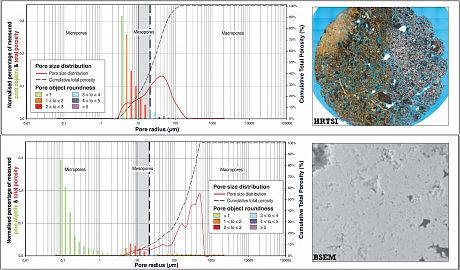PIA is performed on thin-sections using an image acquisition system and analytical software. The acquired images are binarised into solid (matrix) and pore phases, allowing pore spaces to be identified and measured. The PIA technique is applied to high-resolution resin impregnated thin-section scans, BSEM and CL photomicrographs.
Pore system characterisation:
Quantification of the abundance of quartz cement through the image analysis of Optic CL of thin-sections is also provided.


PIA on High Resolution Thin-section Images
The analysis of high-resolution thin-section scanned images (HRTSI) gives good results for grain-rich carbonate and clastic samples.
The potential offered from PIA PSD diagrams, compared to conventional MICP pore-throat size distribution plots, is the possibility to increase the quantitative relationship between the petrographical observations and the effective pore network, providing the unique opportunity to better understand the depositional and/or diagenetic controls over reservoir quality. Potential enhancements to rock-typing schemes (especially in carbonates) through the better quantification of pore systems and pore types are also provided.
PIA on Backscatter Scanning Electron Microscope Images
In micropore-dominated systems, the use of BSEM images is needed for image analysis in order to capture the pores with a size below 8-10µm.
Currently Badley Ashton is investigating the application of this integrated PIA technique to the analysis and characterisation of pore networks within unconventional carbonate reservoirs and shales, where it may provide important information relating to the size, shape and distribution of nano and micropores.
